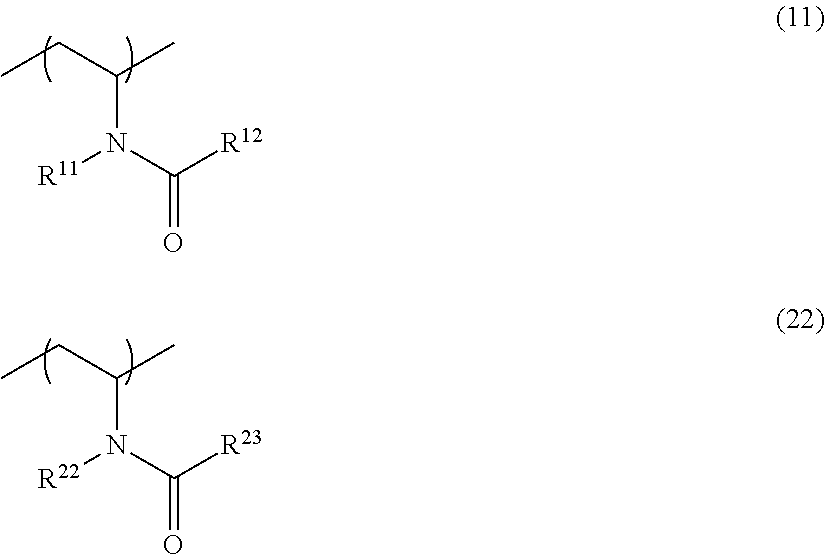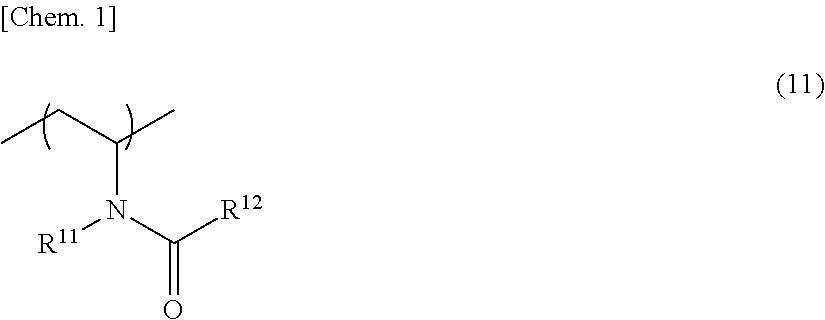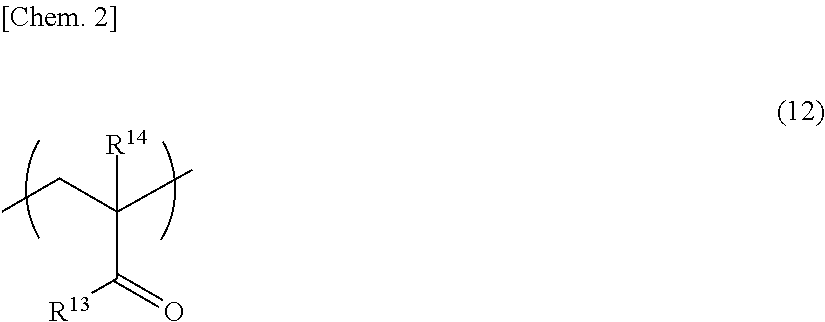Binder Resin for Nonaqueous Secondary Battery Electrode, Binder Resin Composition for Nonaqueous Secondary Battery Electrode Slurry Composition for Nonaqueous Secondary Battery Electrode, Electrode for Nonaqueous Secondary Battery, and Nonaqueous Secondary Battery
a secondary battery electrode and nonaqueous technology, applied in the direction of electrode manufacturing process, electrode collector coating, electrical apparatus, etc., can solve the problems of low binding strength, high recovery cost of solvent during drying, and high environmental impact, and achieve excellent flexibility, excellent binding property, and excellent flexibility
- Summary
- Abstract
- Description
- Claims
- Application Information
AI Technical Summary
Benefits of technology
Problems solved by technology
Method used
Image
Examples
production example 1-1
Production of Polymer (A-1)
[0593]The pH of an aqueous monomer solution obtained by mixing 29.1 parts by mass of N-vinylformamide, 0.9 part by mass of acrylic acid added with an aqueous lithium hydroxide solution so as to have a pH of 9, and 0.8 part by mass of sodium acetate with respect to 70 parts by mass of deionized water was adjusted to 6.3 with phosphoric acid to obtain an adjusted monomer solution.
[0594]This adjusted monomer solution was cooled to 5° C. and then introduced into an adiabatic reactor equipped with a thermometer, and nitrogen aeration was performed for 15 minutes. Thereafter, 1500 ppm (with respect to the monomer) 2,2′-azobis[N-(2-carboxyethyl)-2-methylpropionamidine] (“VA-057” manufactured by Wako Pure Chemical Industries, Ltd.) was added thereto as a 10% by mass aqueous solution, subsequently 200 ppm (with respect to the monomer) t-butyl hydroperoxide was added thereto as a 10% by mass aqueous solution, and further 200 ppm (with respect to the monomer) sodium ...
production example 1-2
Production of Polymer (A-2)
[0605]A polymer in power form was obtained in the same manner as in Production Example 1-1 except using 0.9 part by mass of methyl acrylate instead of 0.9 part by mass of acrylic acid added with an aqueous lithium hydroxide solution so as to have a pH of 9. This was used as a polymer (A-2).
[0606]Meanwhile, the viscosity average molecular weight (Mv) of the polymer (A-2) calculated by the same method as that of the polymer (A-1) was 2,370,000 in terms of PNVF.
production example 1-3
Production of Polymer (A-3)>
[0607]A polymer in power form was obtained in the same manner as in Production Example 1-1 except using 0.9 part by mass of methoxypolyethylene glycol monomethacrylate (“BLEMMER PME-200” manufactured by NOF CORPORATION) instead of 0.9 part by mass of acrylic acid added with an aqueous lithium hydroxide solution so as to have a pH of 9. This was used as a polymer (A-3).
[0608]Meanwhile, the viscosity average molecular weight (Mv) of the polymer (A-3) calculated by the same method as that of the polymer (A-1) was 2,900,000 in terms of PNVF.
[0609]
[0610]A polyacrylic acid (mass average molecular weight (Mw): about 1,000,000) manufactured by Wako Pure Chemical Industries, Ltd. was used as a polymer (A-5) as it was.
PUM
| Property | Measurement | Unit |
|---|---|---|
| particle size | aaaaa | aaaaa |
| thickness | aaaaa | aaaaa |
| humidity | aaaaa | aaaaa |
Abstract
Description
Claims
Application Information
 Login to View More
Login to View More - R&D
- Intellectual Property
- Life Sciences
- Materials
- Tech Scout
- Unparalleled Data Quality
- Higher Quality Content
- 60% Fewer Hallucinations
Browse by: Latest US Patents, China's latest patents, Technical Efficacy Thesaurus, Application Domain, Technology Topic, Popular Technical Reports.
© 2025 PatSnap. All rights reserved.Legal|Privacy policy|Modern Slavery Act Transparency Statement|Sitemap|About US| Contact US: help@patsnap.com



